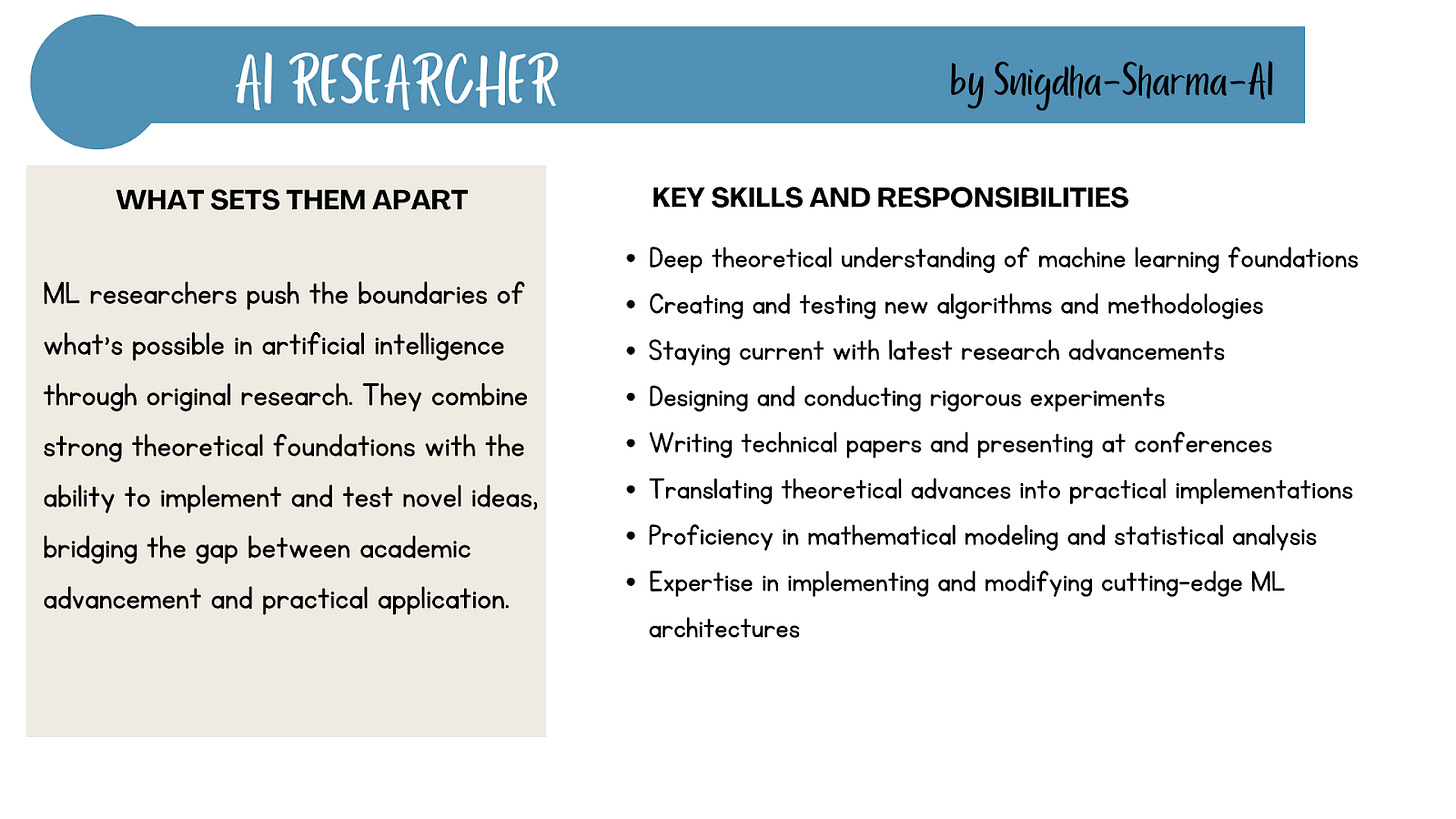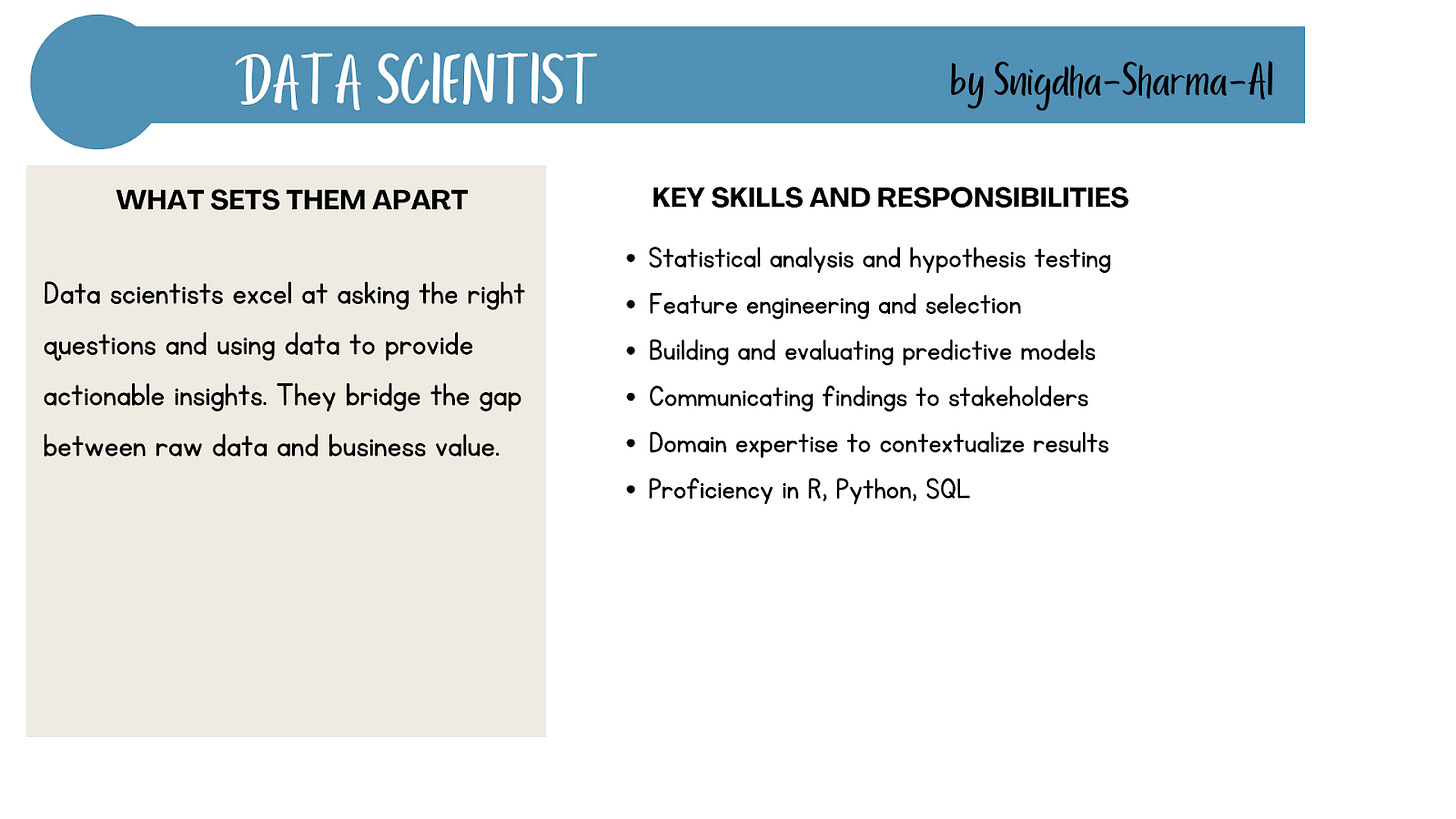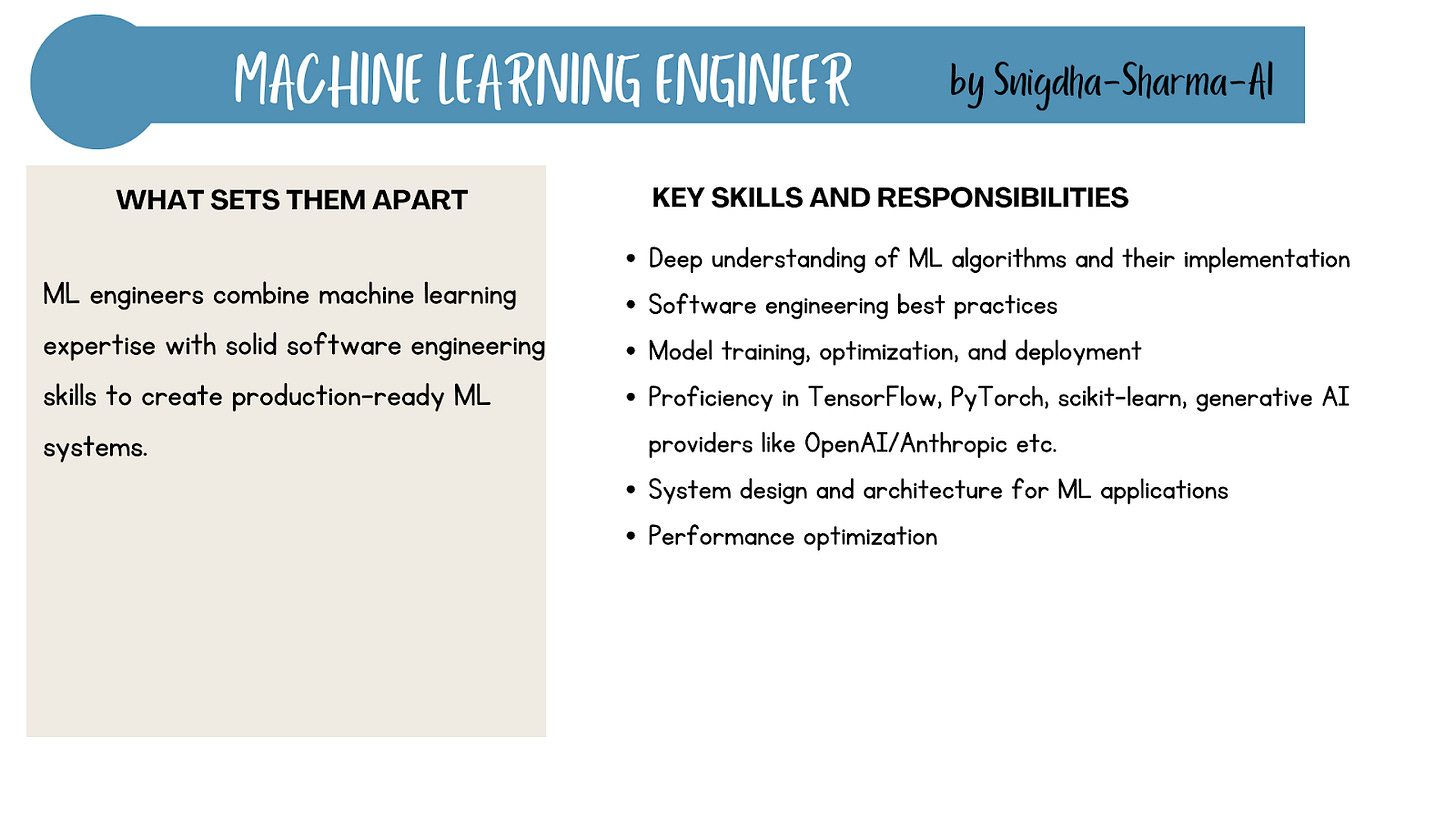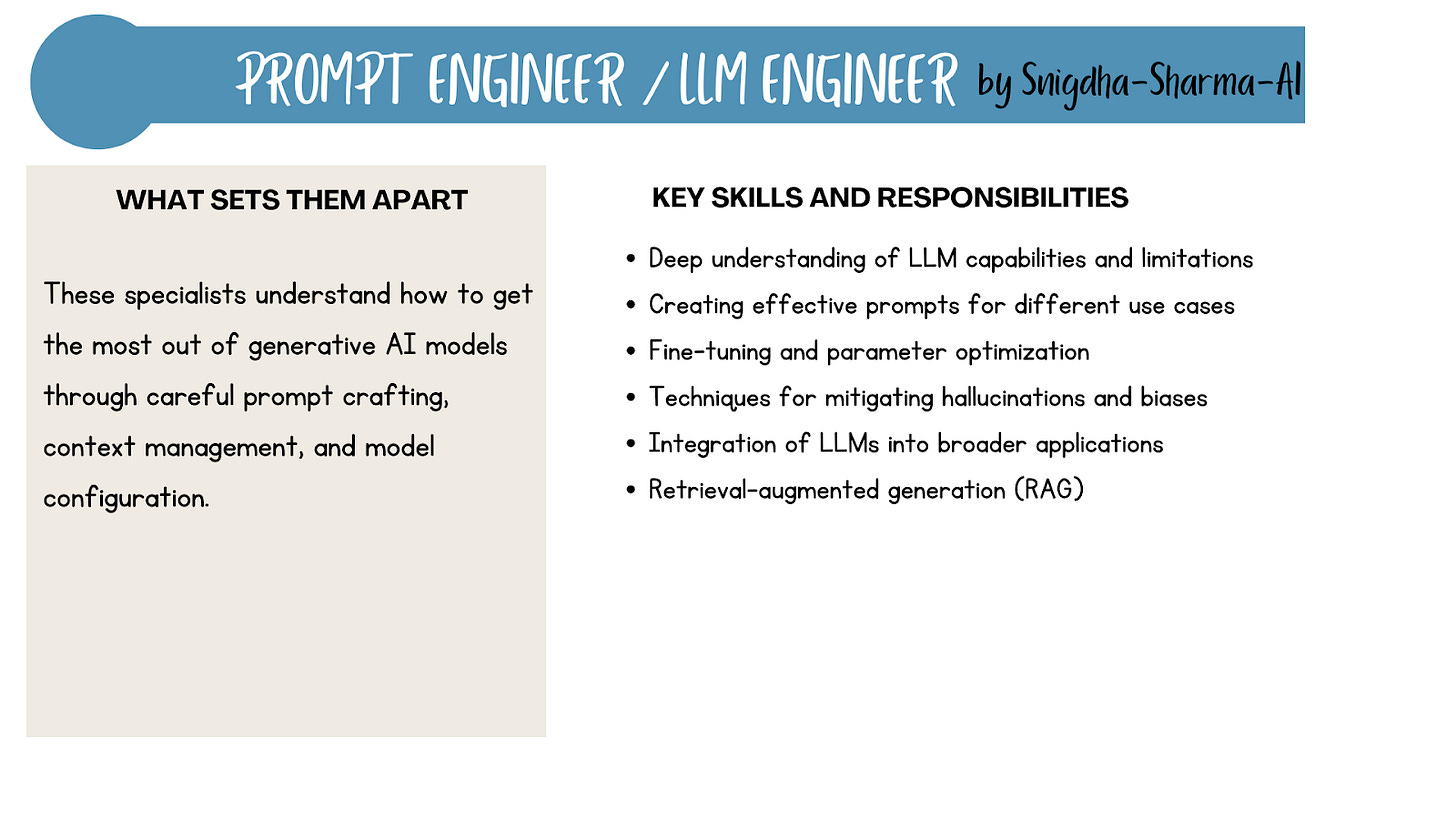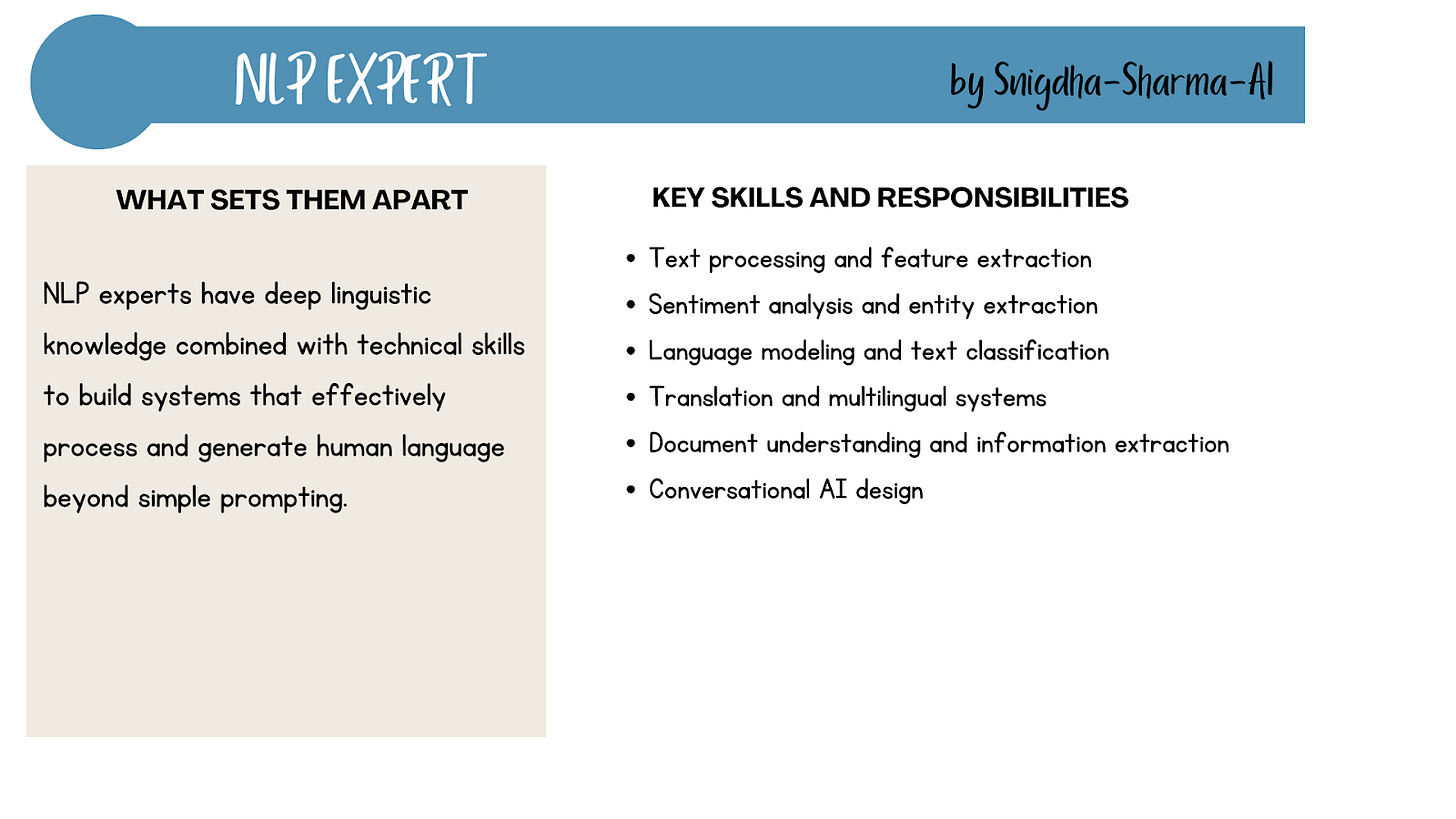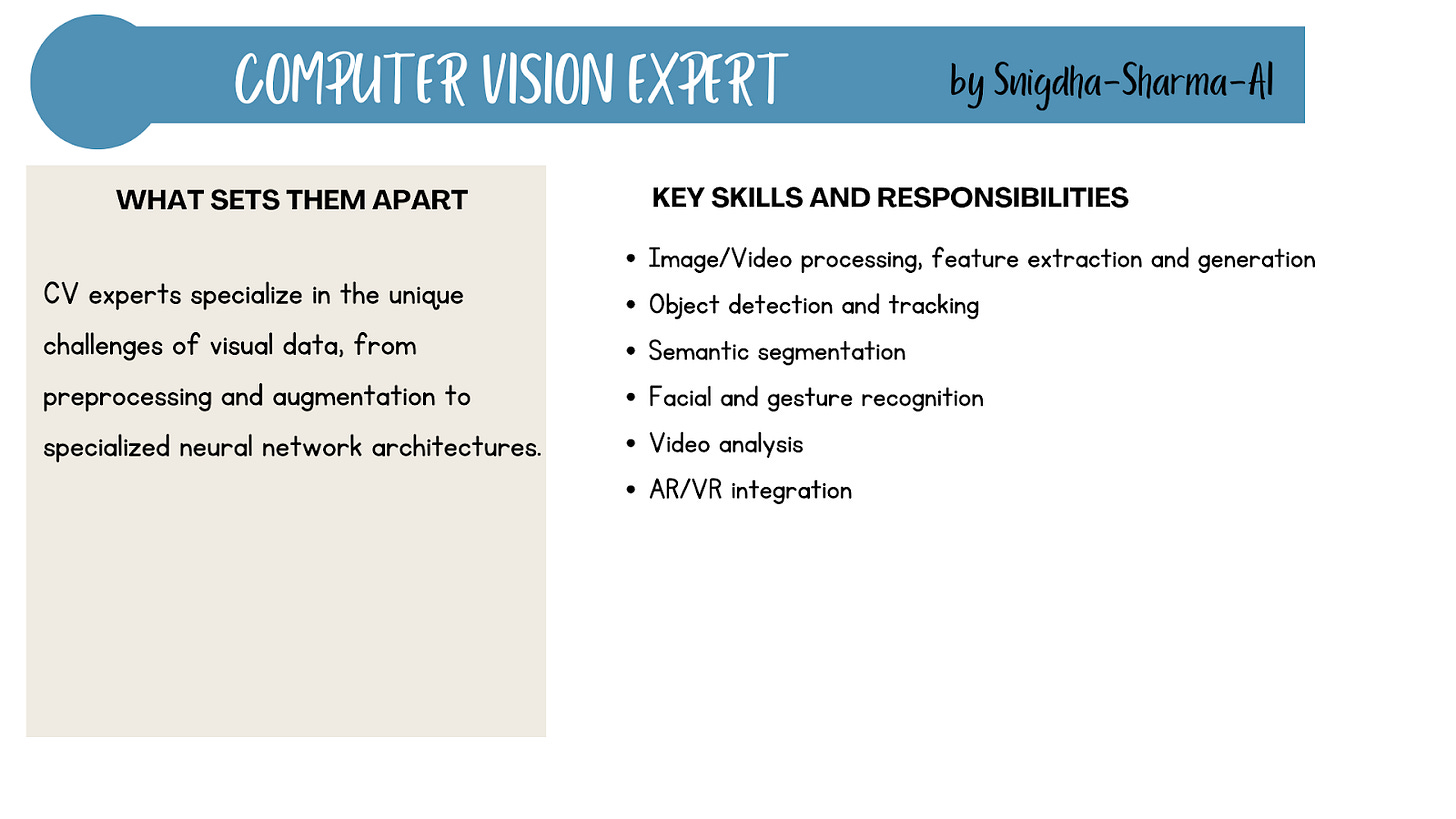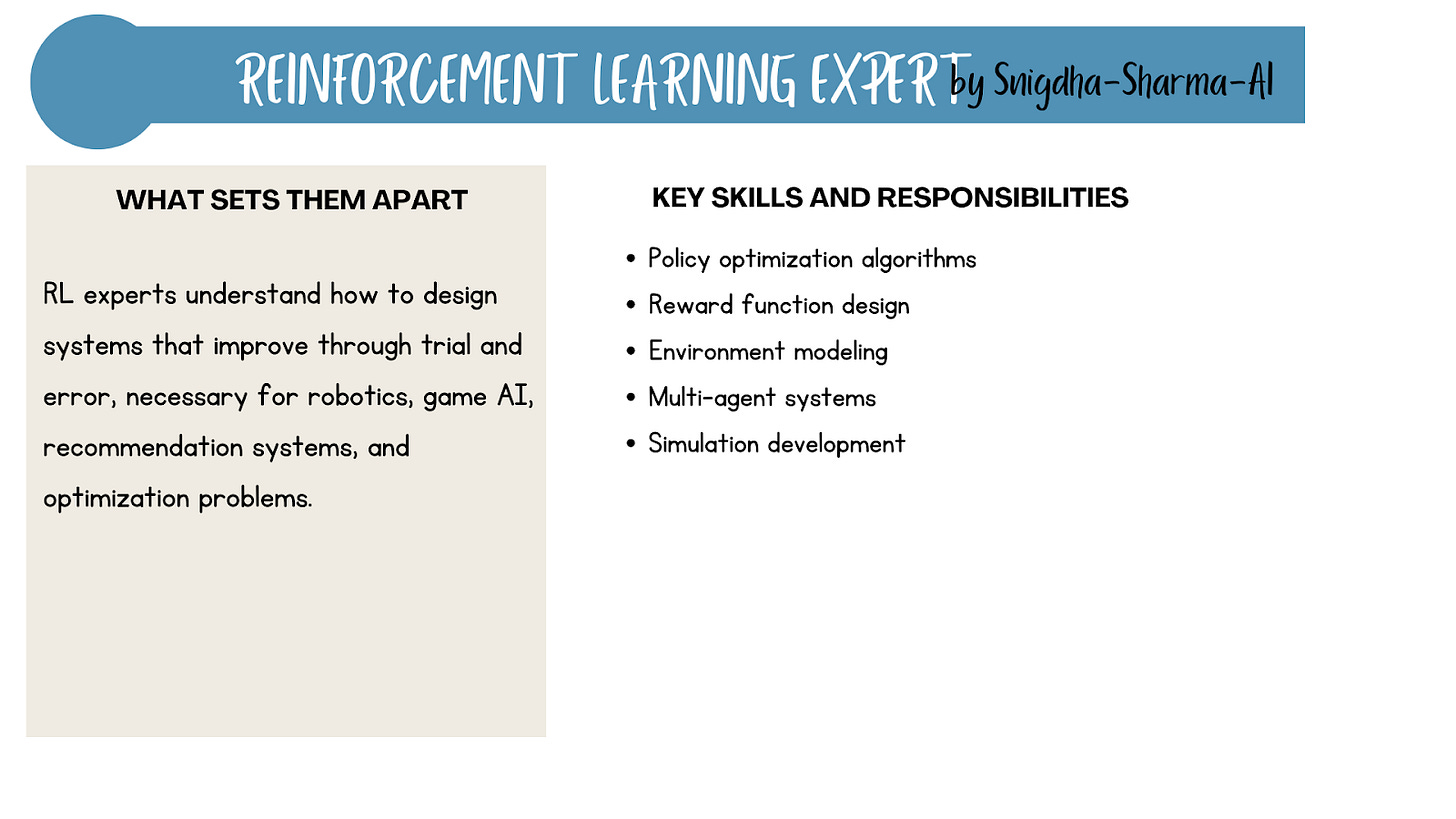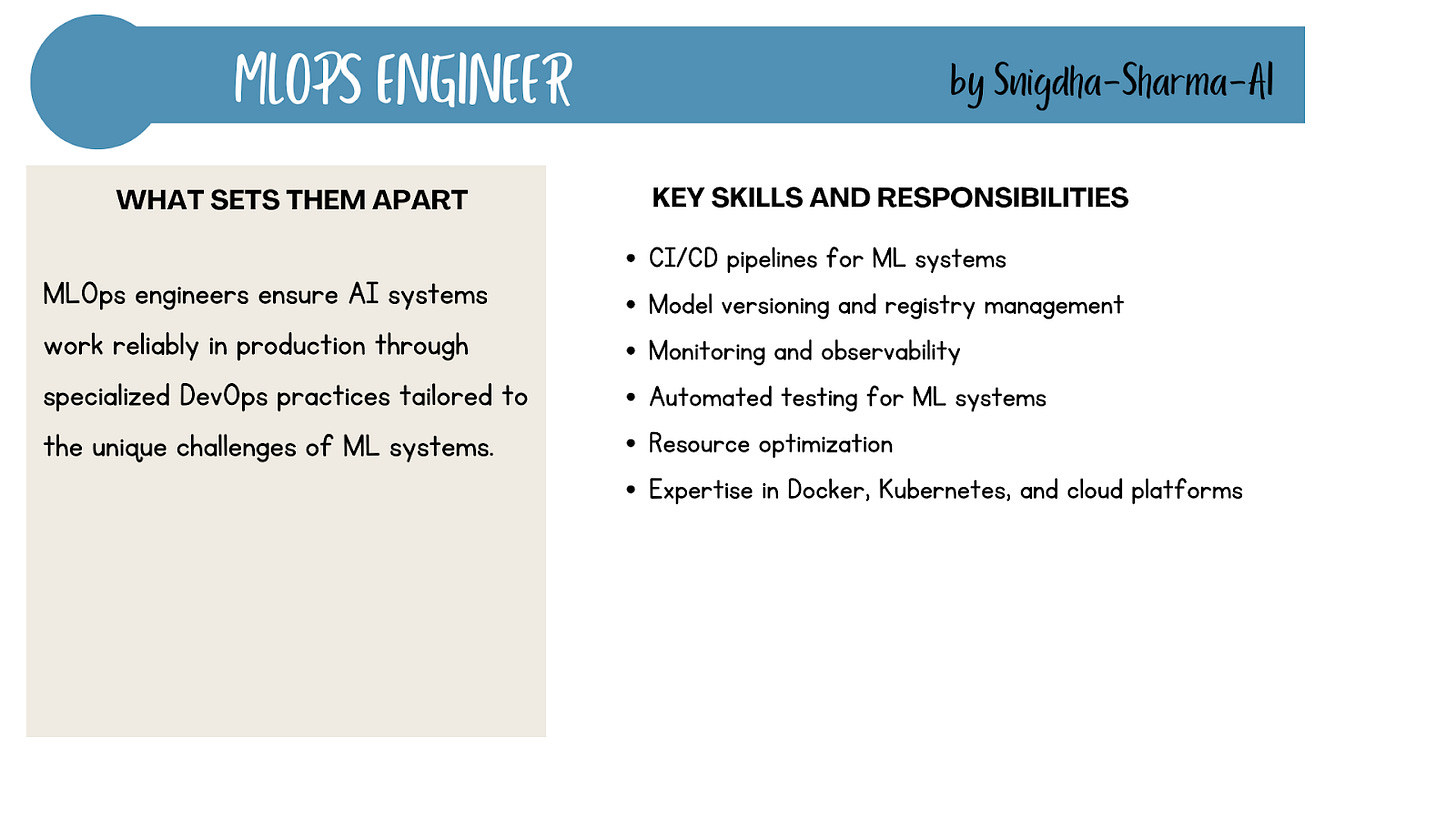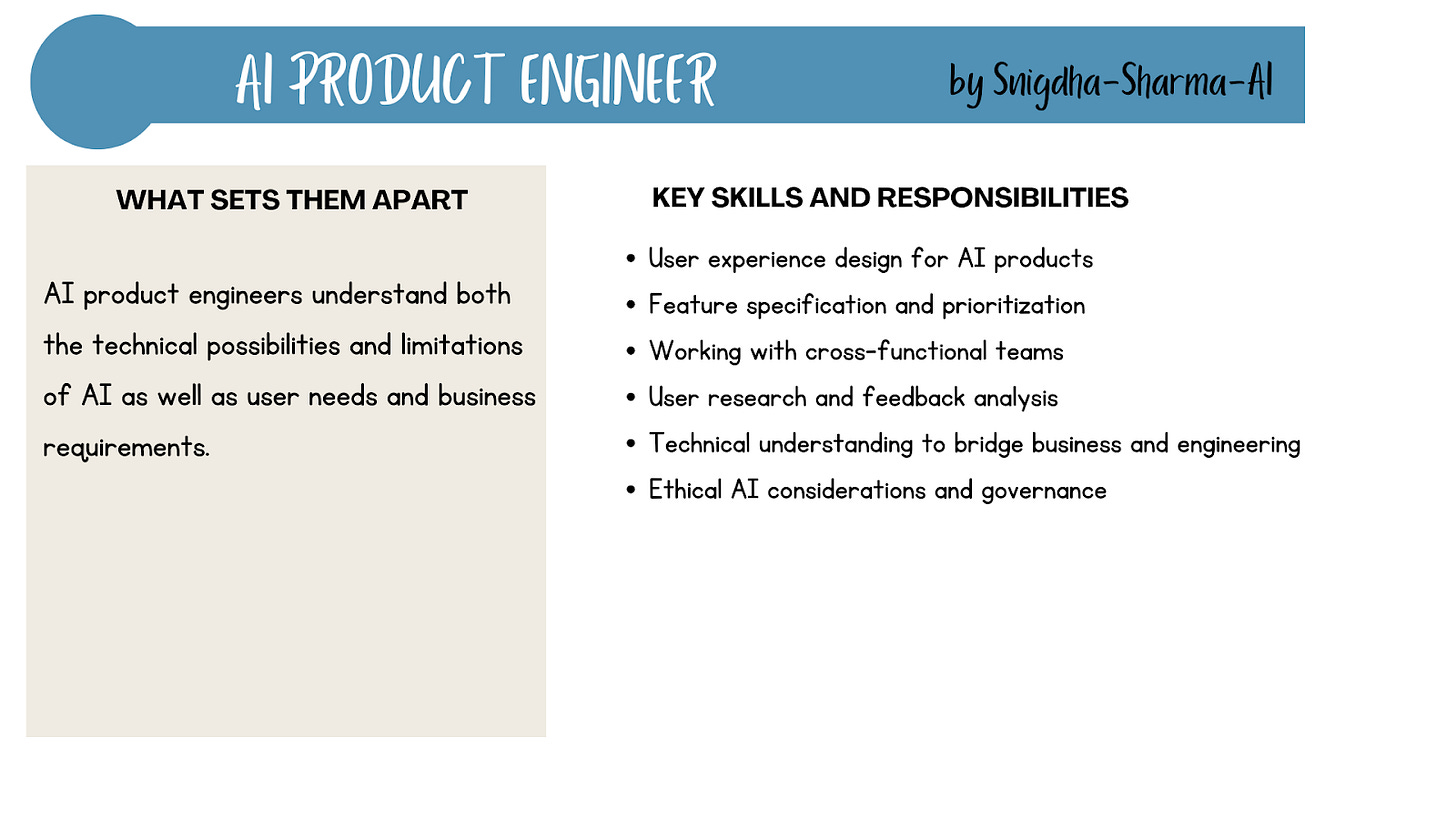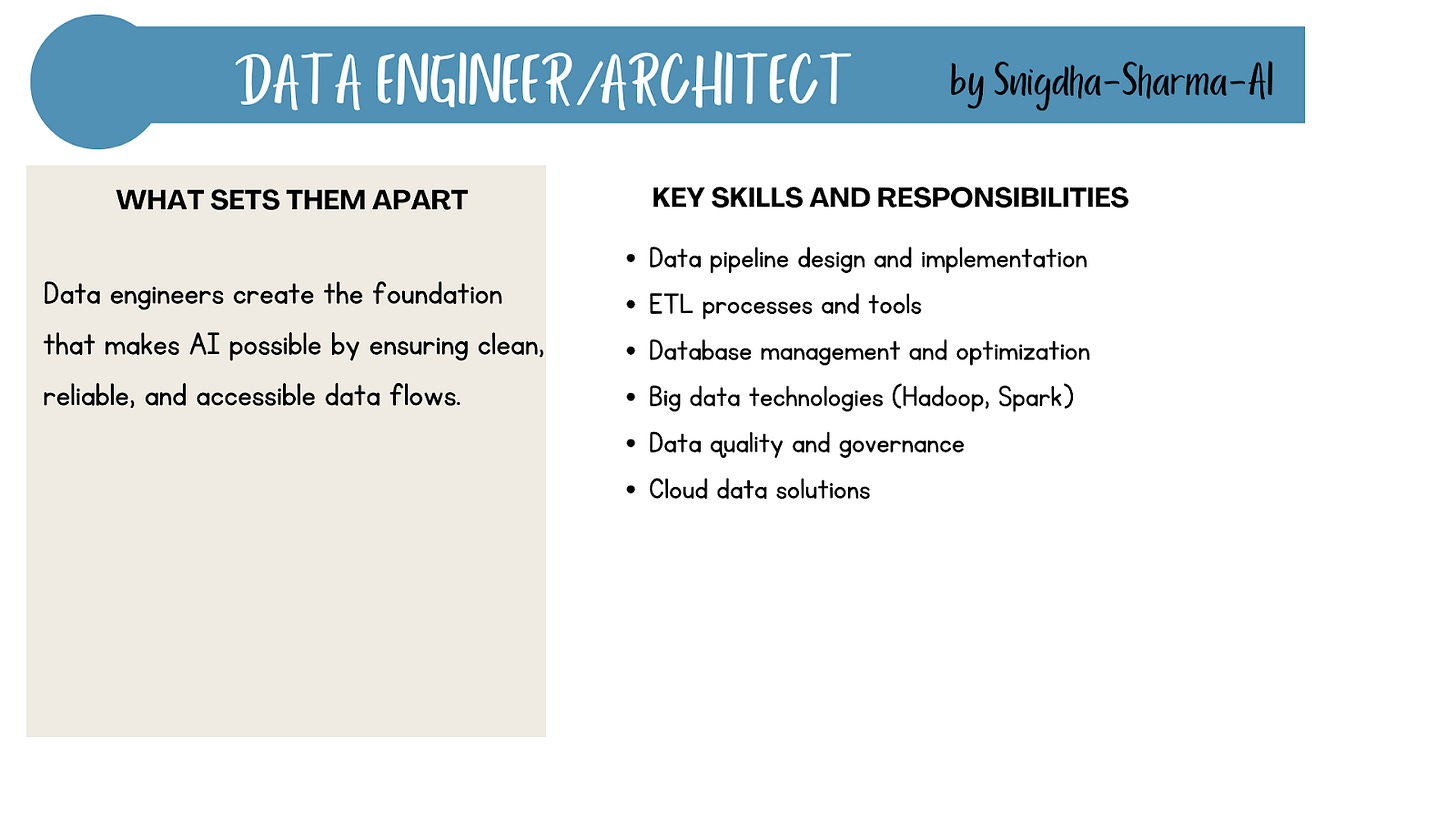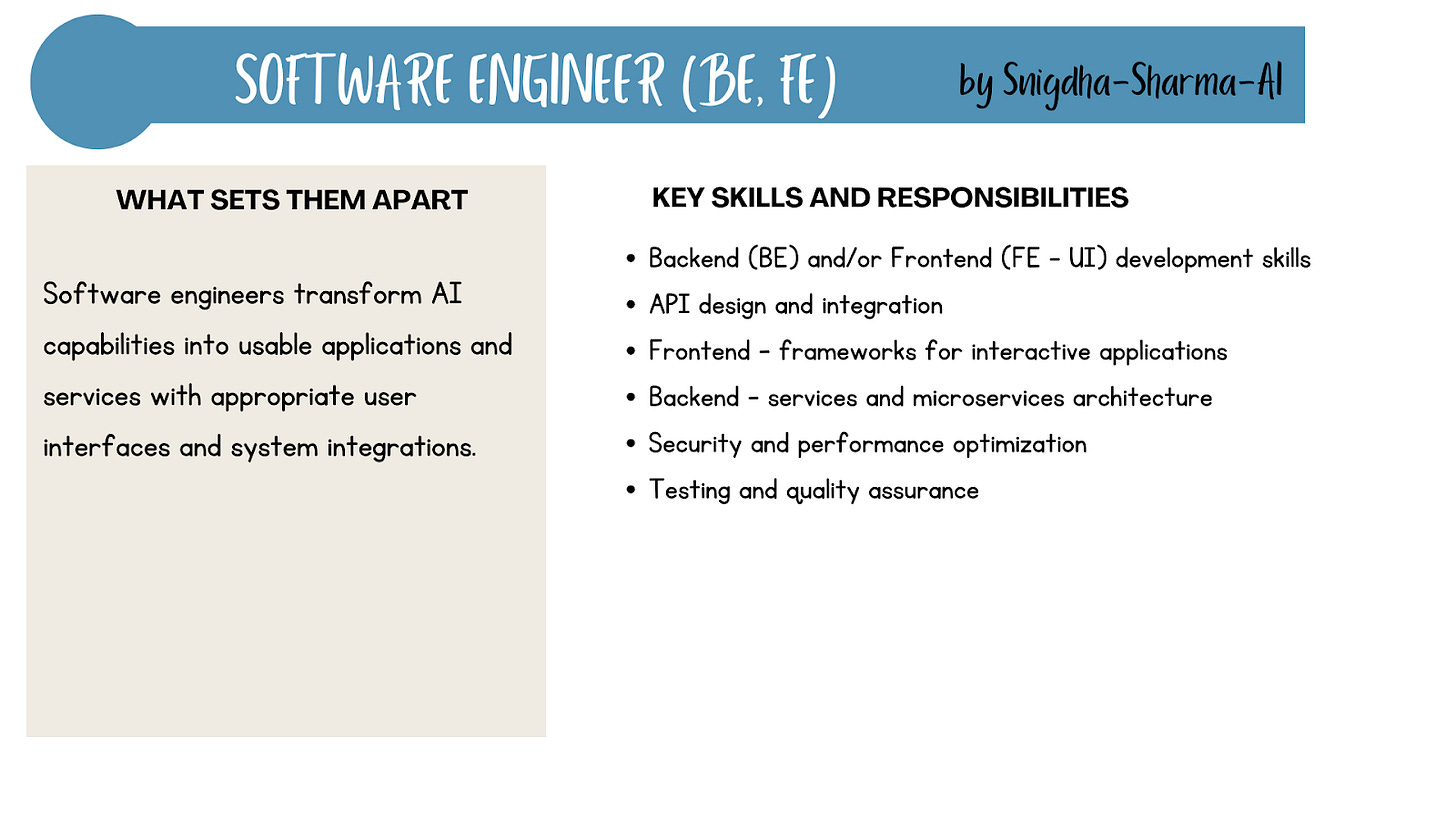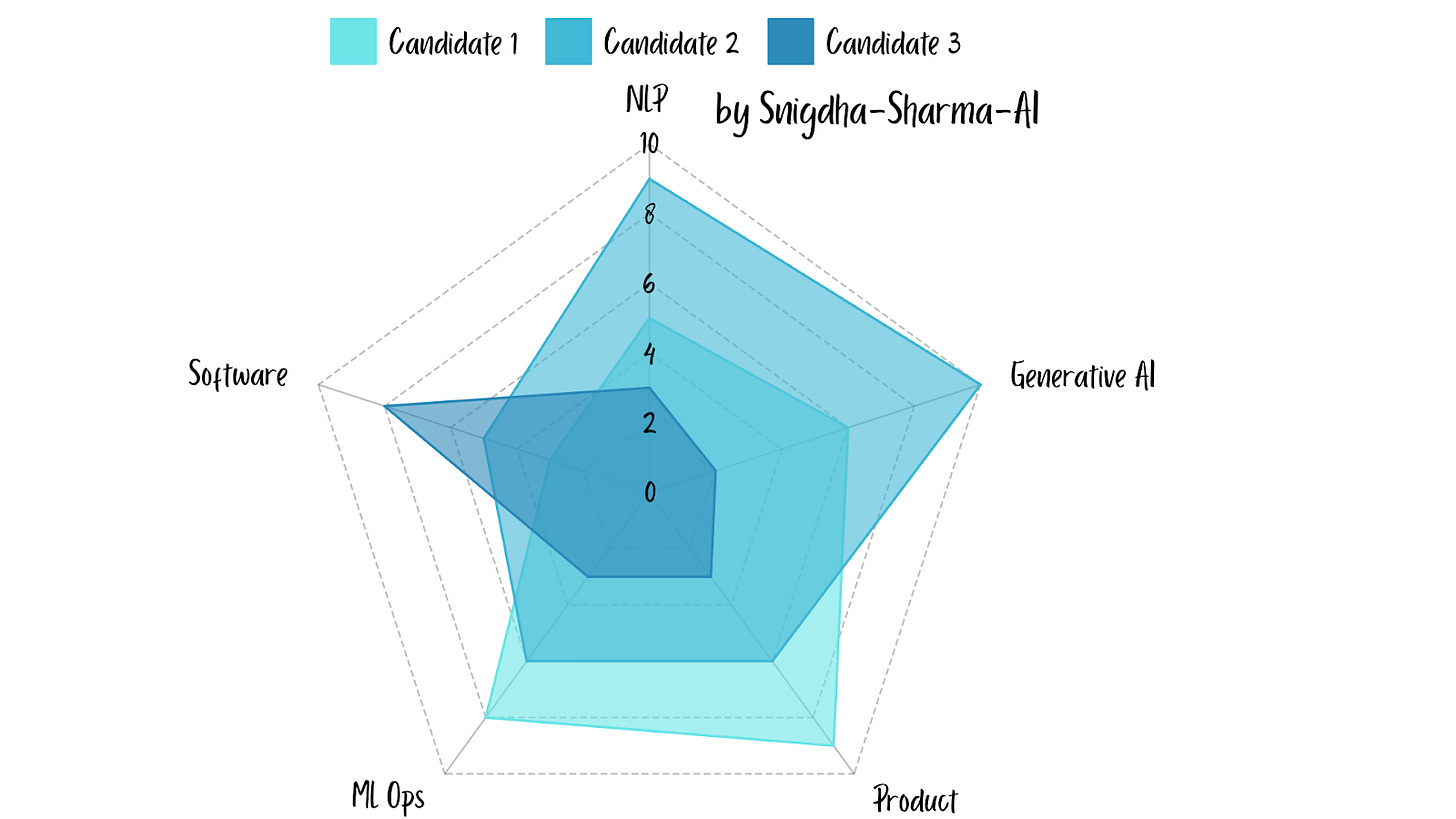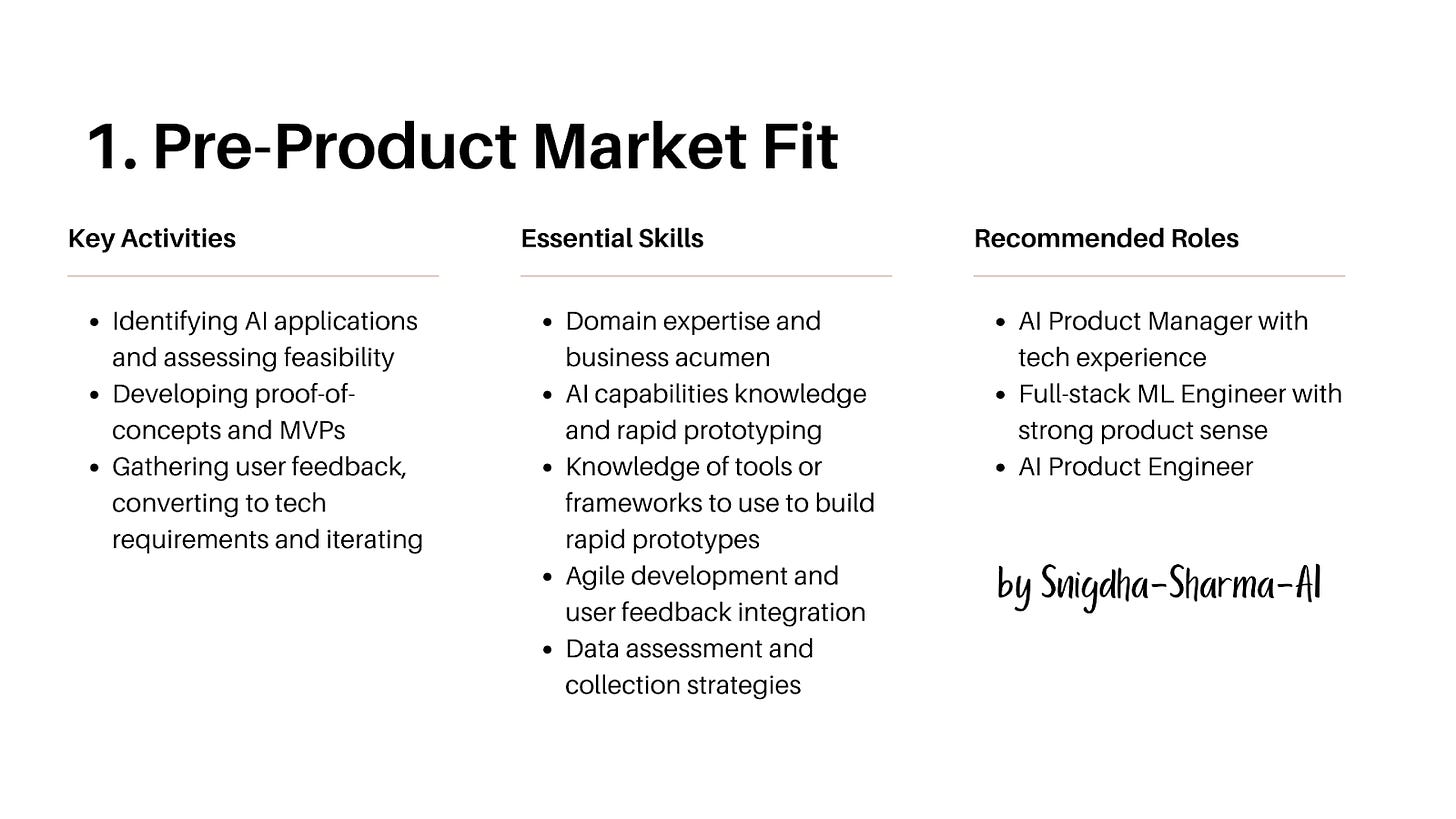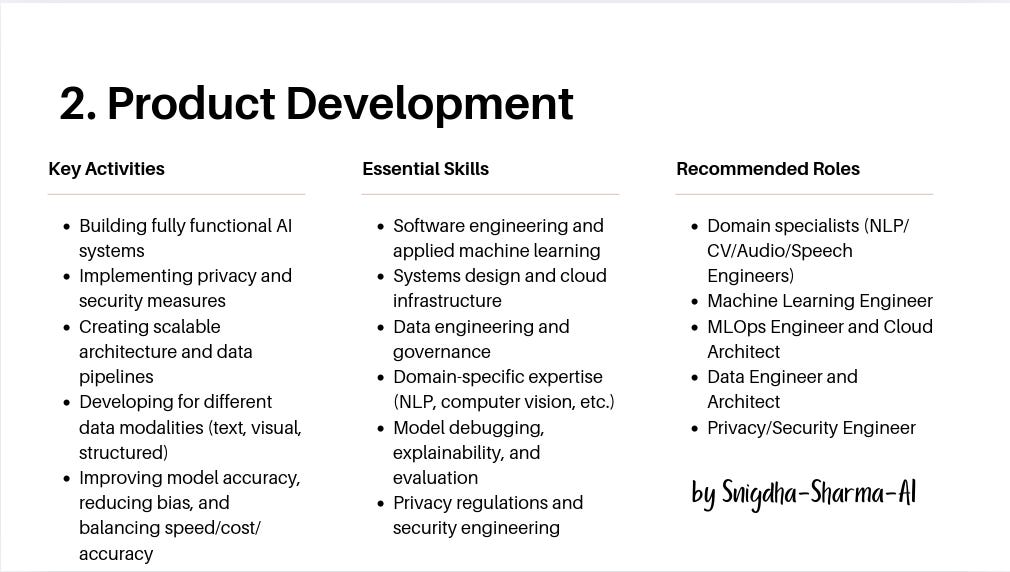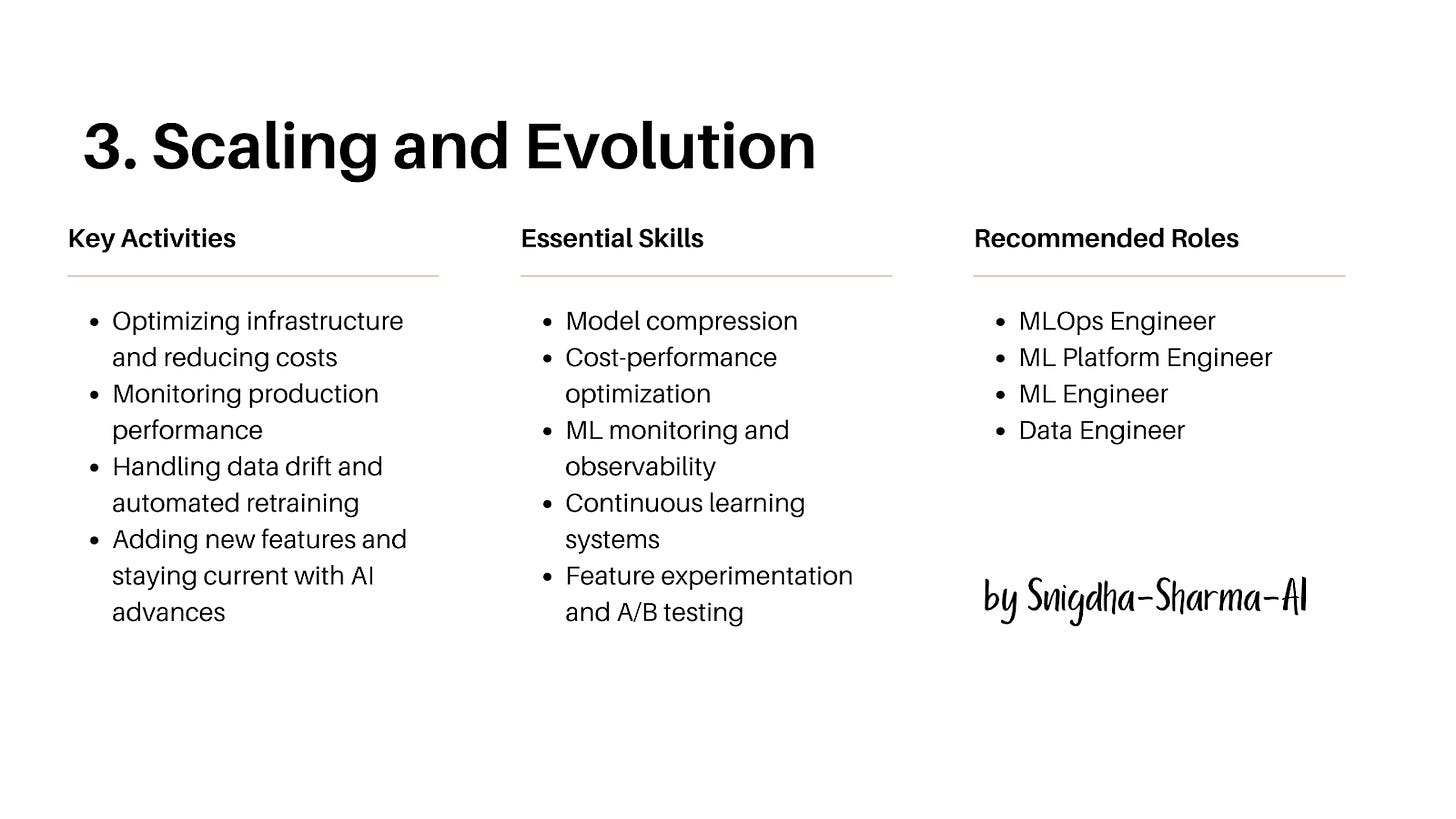How to Hire for your AI Initiatives?
Do you need a Data Scientist, LLM Engineer, a domain expert or a mix of these?
If you’re new to this blog - welcome! I’m Snigdha, an AI developer who has developed and led AI products at startups (early stage and nearing IPOs) and enterprises.
On this blog, I'll be sharing insights on AI development, product leadership, and innovation - most of which result from AI projects and consultations with my clients at MindChords.AI.
Read more about why I started this blog - the inspiration and mission behind NextWorldTrio
It’s 2025 and teams have already tried integrating AI into their operations, products, and services. Some have done so successfully, others are still struggling. Building successful AI initiatives requires more than just access to the latest GenAI models and GPUs - it demands the right talent with the right skills at the right time.
The challenge? The AI talent landscape is getting more complex, constantly shifting, and often misunderstood. With new tools, models emerging every week, we can hardly rely on past experience in XYZ tools or models or algorithms as our search filter while hiring.
The right way? Many organisations make the critical mistake of viewing AI primarily through the lens of generative AI and large language models (LLMs), when in reality, effective AI development encompasses a much broader spectrum of techniques, and expertise.
This comprehensive guide will help you navigate the process of hiring for AI initiatives by examining the diverse skills required, at different stages of development. Whether you're a startup founder, or a small-medium business owner, understanding how to assemble the right AI talent for your AI initiatives is necessary for turning your AI vision into reality.
1. Will GenAI alone be sufficient for business needs?
1.1 First things first. AI >>> GenAI
While ChatGPT, Claude, DeepSeek etc. have captured the public imagination and dominated headlines, they represent just one facet of the broader AI ecosystem, although still a major facet. Let me explain how.
First, let’s see multiple domains that exist within AI:
Machine Learning (ML): The fundamental ability to build systems that learn from data, encompassing supervised, unsupervised, and semi-supervised learning approaches.
Deep Learning: Specialised and complex neural network architectures that excel at pattern recognition in complex data types - audio, image or text.
Computer Vision (CV): Systems that specialise in interpreting, understanding visual information from the world and now even generating images and videos.
Natural Language Processing (NLP): Beyond just generating text, this includes language understanding, translation, sentiment analysis, entity extraction and a lot more - basically anything dealing with text. Also note that most AI based systems that work on speech internally work by converting speech to text and then processing the underlying text.
Speech and Audio Processing: Similar to how NLP (Natural Language Processing) handles text and CV (Computer Vision) handles images, Speech and Audio Processing is the umbrella term for working with sound-based data. This includes speech to text, text to speech, speaker recognition, music audio generation etc.
Reinforcement Learning (RL): Training agents through reward mechanisms, simulations and historical data to optimise decision-making processes. This is generally useful for training complex models like LLMs, robotics and any AI system that is designed to deal with real world unpredictable data and needs to learn from its interactions with the outside world - just like we humans do.
Data Engineering: The foundation that makes AI possible through efficient data collection, storage, and processing. This is often overlooked. But please understand that algorithms learn what’s in your data. If your data is not optimised for AI models, you won’t get any benefits even by using the most expensive models out there.
MLOps: The operational framework that enables AI systems to be deployed reliably and at scale.
Generative AI: has rendered a lot of traditional techniques/algorithms in NLP, CV, Speech/Audio processing and traditional ML somewhat obsolete. And with no-code and low-code tools now available wrapping these GenAI technologies, MLOps role is somewhat obliterated as well (for small projects and teams). For a lot of common use cases today - like chatbot development, AI voice calling, video generation, you only need knowledge of how to use these simple GenAI tools to develop POCs.
While generative AI offers impressive capabilities with relatively low barriers to entry, building AI solutions that can withstand production data, regulations, unwanted model updates, operating at scale (and whatnot) often requires deeper expertise. The most successful AI initiatives typically integrate multiple AI approaches and techniques tailored specifically to the problem at hand.
And that’s where expertise only in using Generative AI tools - falls short. You need an understanding of how these simple-to-use tools operate under the hood to optimise them for your data and your business use case.
1.2 Is GenAI the only tech that can drive value for your business? No.
Organisations that focus exclusively on generative AI may find themselves:
Limited to use cases centered around text and image generation
Unable to leverage the full potential of their proprietary data
Struggling with accuracy, reliability, and bias issues
Facing challenges in scaling and maintaining their systems
Missing opportunities for truly innovative applications of AI
2. What (dev) roles typically exist in AI teams and what do they each do?
I hear you. There are more AI roles available in the market than cats in TikTok videos. Each role brings unique skills to the table, though there can be significant overlap depending on the specific context of each organisation. Let's explore the key roles, skills they demand and what makes each distinct:
2.1 AI Researcher
Core Focus: Advancing the state of the art in machine learning through novel approaches and techniques
2.2 Data Scientist
Core Focus: Extracting insights and predictions from data
2.3 Machine Learning Engineer
Core Focus: Building and deploying machine learning systems
2.4 Prompt Engineer / LLM Engineer
Core Focus: Designing interactions with and optimising large language models.
Note: Please do not confuse this with people who write a few sentences to get some response out of LLMs - everyone’s a prompt engineer by those standards.
2.5 NLP Expert
Core Focus: Building systems that understand and generate human language
2.6 Computer Vision Expert
Core Focus: Creating systems that interpret visual information
2.7 Reinforcement Learning Expert
Core Focus: Building systems that learn through interaction and feedback
2.8 MLOps Engineer
Core Focus: Creating infrastructure and processes for reliable AI systems
2.9 AI Product Engineer
Core Focus: Translating AI capabilities into valuable product features
2.10 Data Engineer/Architect
Core Focus: Building data infrastructure that enables AI
2.11 Software Engineer (BE, FE)
Core Focus: Building production-quality applications that integrate AI capabilities
3. Are These Roles Exclusive? Not at all.
While we've outlined distinct roles above, the reality of AI talent is much more fluid. The boundaries between these roles often blur, especially in smaller organisations or early-stage initiatives. Here's a more pragmatic approach to thinking about AI talent:
3.1 Focus on Skills, Not Titles
Job titles in AI vary tremendously across organisations and often don't accurately reflect the actual work being done. Instead of fixating on specific role titles, identify the core skills your initiative requires:
Are you looking to build a product from scratch or trying to optimise your AI systems for accuracy and/or cost?
Do you have product market fit and know exactly what you want to build or are you still pivoting frequently?
Is your focus on research or production development and deployment?
Do you need to develop novel algorithms or can you leverage existing ones?
Do you primarily deal with images, videos, unstructured text/documents, chatbot-like conversations, audio, speech or a mix of these?
Need help figuring out what skills to hire for your AI initiatives? Reach out via a DM here or on LinkedIn
By mapping required skills to your specific challenges, you can create more accurate job descriptions and identify candidates whose abilities align with your actual needs.
3.2 The Value of T-Shaped Professionals
Many successful AI practitioners have what's called a "T-shaped" skill profile:
Deep expertise in one particular area (the vertical bar of the T)
Broader working knowledge across multiple related domains (the horizontal bar)
These professionals can dive deep when needed but also understand how their work fits into the broader system, making them particularly valuable for broader projects.
3.3 Learnability and transferable skills
Some skills are easily learnable and/or transferable, so trying to find the candidates that tick all boxes is not prudent.
Focus hiring on core capabilities that are difficult to develop quickly:
Strong analytical thinking and problem-solving abilities
Experience with similar technical challenges at scale
Proven track record of learning new technologies independently
Look for experience in broader domains like NLP, CV as per your project requirements
4. Whom to hire - Generalists, Specialists or External Consultants?
Different organisational contexts call for different approaches to building an AI team, but here’s a general blueprint:
4.1 For Small Teams and Early-Stage Product Initiatives
When resources are limited, prioritise versatility and breadth:
Hire generalists with overlapping skills across multiple domains
Look for professionals who have successfully worn multiple hats
Prioritise those with end-to-end product building experience
Value adaptability and learning ability over ultra-specialised knowledge
Consider full-stack AI engineers who can handle everything from data processing to deployment - yes, they do exist ;)
If not sure, consider reaching out here for an AI team as a service
4.2 For Larger Organisations and Mature Initiatives
As your AI initiatives scale, increased specialisation might become beneficial, depending on what problems your current team is facing:
Create complementary teams of specialists and generalists
Consider a matrix structure where specialists serve multiple projects
Specialist in one skill can be a generalist in another and vice versa
Assess current team skill set and see where your team is currently struggling the most
If not sure, consider reaching out here for specialised skill requirements
4.3 Alternative: External Consultants/Partnerships
For organisations without the resources or need for a full-time AI team:
Engage specialised AI consultancies for specific projects
Utilize no/low code tools, AI platform services for standard capabilities or to assess use cases
Consider hybrid models with core internal talent supplemented by external experts
Remember that the optimal team structure will evolve as your AI initiatives mature. Start with the configuration that matches your current needs and be prepared to adapt as your requirements change.
5. What skills to hire for each stage of your AI initiative
AI initiatives progress through distinct phases, each requiring different combinations of skills and expertise. Understanding these stages can help you make strategic hiring decisions at the right time.
Any AI initiative roughly falls into these 3 broad stages:
1. Pre-Product Market Fit
2. Product Development
3. Scaling
And here are the (development related) skills that should be the focus area in each of these stages. Please note that actual skills required can still vary greatly for different use cases, but generally speaking, all AI application based initiatives (as opposed to research based initiatives) follow this breakdown:
Why These Skills Matter: This foundational phase determines whether you're solving the right problems with AI. A balance of business insight and technical feasibility is crucial to avoid creating solutions looking for problems or pursuing technically impractical ideas. The ability to quickly prototype, gather meaningful feedback, and pivot based on user needs prevents wasting resources on AI projects that won't deliver value.
Why These Skills Matter: Product development transforms promising ideas into robust, production-ready systems. Technical implementation skills ensure the AI functions correctly, while expertise in privacy, security, and system architecture prevents costly redesigns later. Domain-specific knowledge (in areas like NLP or computer vision) is essential for high-quality models, and skills in fairness and explainability help build trustworthy AI that meets ethical standards and regulatory requirements.
Why These Skills Matter: As AI systems mature and usage grows, skills in optimisation and scaling become important for sustainable operations. Without them, costs can quickly spiral out of control as demand increases. Monitoring and continuous improvement capabilities ensure the AI maintains its performance over time, even as data patterns shift. Ability to convert research to implementation helps incorporate cutting-edge advances, keeping your AI products competitive.
6. How to avoid hiring the wrong talent?
Learning from others' mistakes can help you avoid common pitfalls:
6.1 Overemphasis on Academic Credentials
While academic background matters, especially for research-intensive roles, don't overlook:
Practitioners with proven implementation experience
Self-taught experts with strong portfolios
Professionals from adjacent fields with transferable skills
Practical problem-solving ability often matters more than theoretical knowledge.
6.2 The "AI Unicorn" Fallacy
Expecting to find individuals who excel across all AI disciplines is unrealistic. Instead:
Recruit for complementary skills with diverse specialisations
Hire external consultants for specialised or short term needs.
6.3 Neglecting Data Foundations
Many organisations rush to build sophisticated models before establishing solid data practices:
Invest early in data engineering and governance
Address data quality issues before scaling AI development
Create clear data ownership and access policies
6.4 Isolation from Business Context
AI teams disconnected from business realities often build technically impressive systems that fail to deliver value:
Embed business domain experts within AI teams
Establish regular touch points with end users and AI Leads
Create metrics that align with business outcomes, not just technical performance
6.5 Overlooking Operational Requirements
The gap between a working prototype and a reliable production system is often underestimated:
Include MLOps considerations from early stages
Budget for monitoring, maintenance, and updating
Plan for graceful degradation and fallback mechanisms
7. So, what’s the next step for you?
Beyond understanding the roles and stages, successful AI initiatives require thoughtful strategy in how you build and develop your team. Here are key considerations and approaches:
7.1 Assessing Your Current Capabilities
Before making hiring decisions, inventory your existing talent:
Assess leadership's AI literacy and practical experience
Identify team members with relevant or tangential skills or aptitude for AI
If unsure, connect with consultants (or me!) to assess your skill requirements, what your team can easily learn on their own, where you need to hire for specialists.
This assessment helps identify gaps and leverage existing strengths.
7.2 Build vs. Buy vs. Partner Decisions
For each capability, consider the optimal sourcing strategy:
Build: Develop internal talent through hiring and training
Buy: Bring in external consultants with established capabilities or agencies offering a diverse skill set
Partner: Form alliances with AI consultants to help you make informed decisions along the way.
The right mix depends on factors like strategic importance, time constraints, and resource availability.
Building effective AI teams requires a thoughtful approach that goes beyond simply hiring people with "AI" in their job titles. By understanding the distinct roles, required skills at each development stage, and strategic considerations in team building, you can create AI initiatives with a much higher probability of success.
7.3 Remember these key principles:
Look beyond generative AI to consider the full spectrum of AI disciplines relevant to your challenges.
Focus on skills over titles, recognising that the most valuable team members often span multiple traditional role boundaries.
Match skill composition to your development stage, bringing in specialised expertise when and where it's needed.
Whether you're a startup founder building your dream AI team, or an established business looking to make the best of what AI has to offer, these principles will help you build teams capable of turning AI potential into real-world returns. With the right people in the right roles, your AI initiatives can move beyond the hype to deliver genuine transformation.



